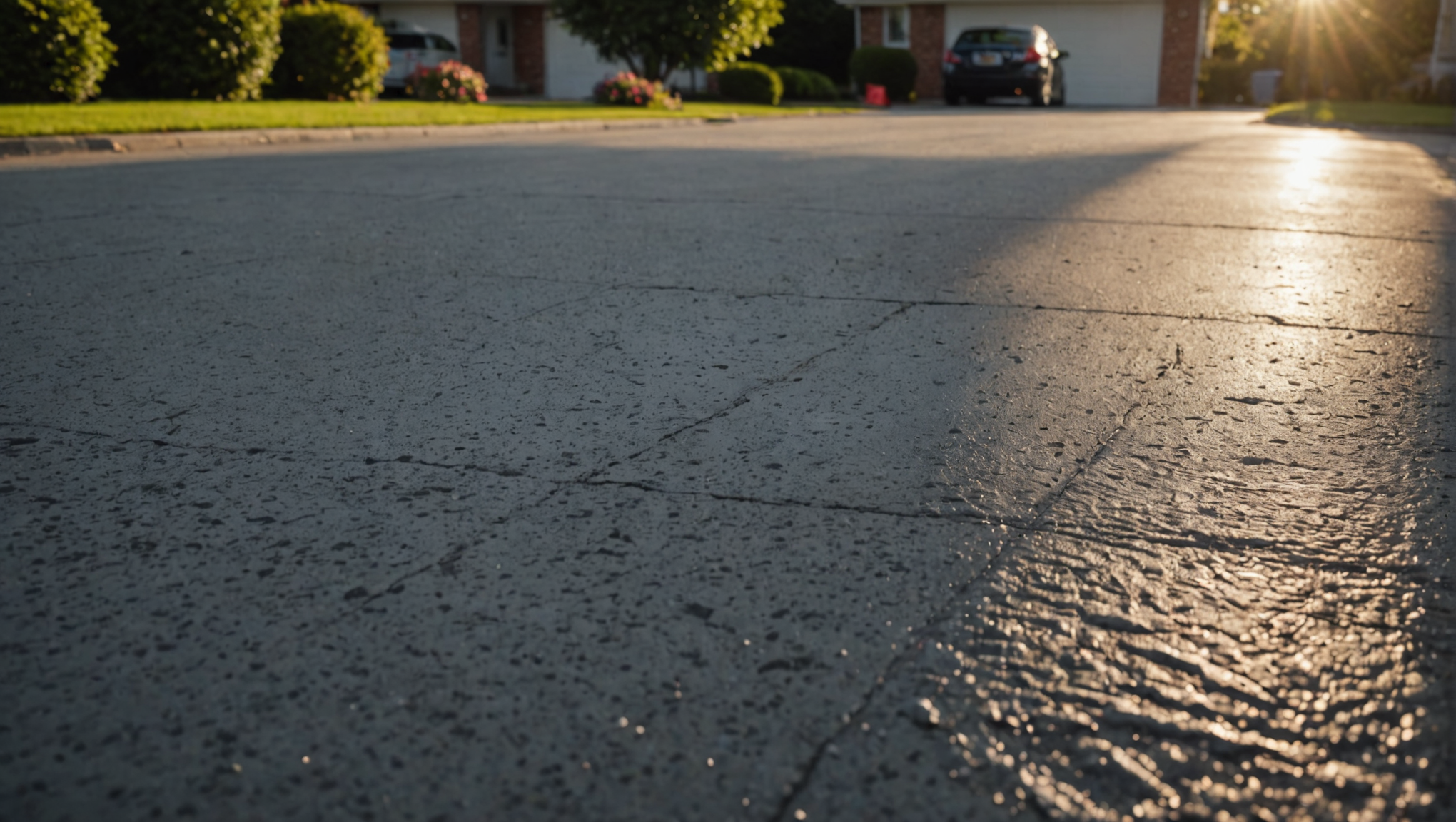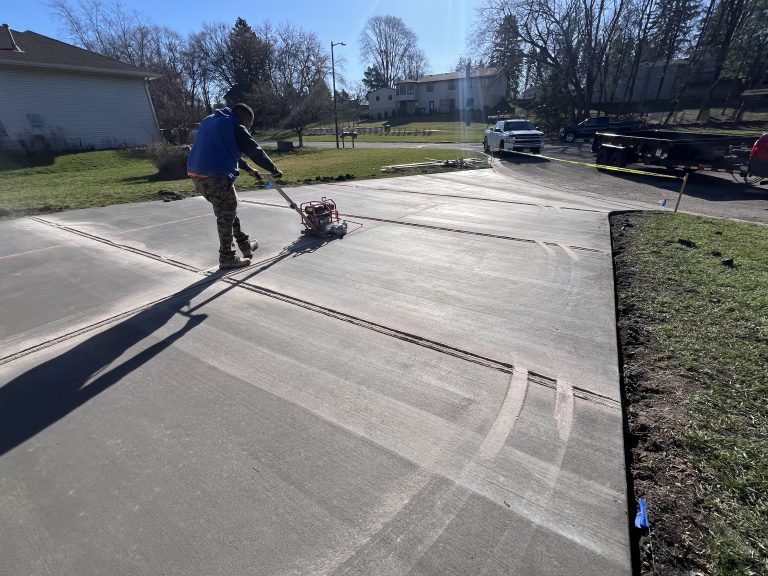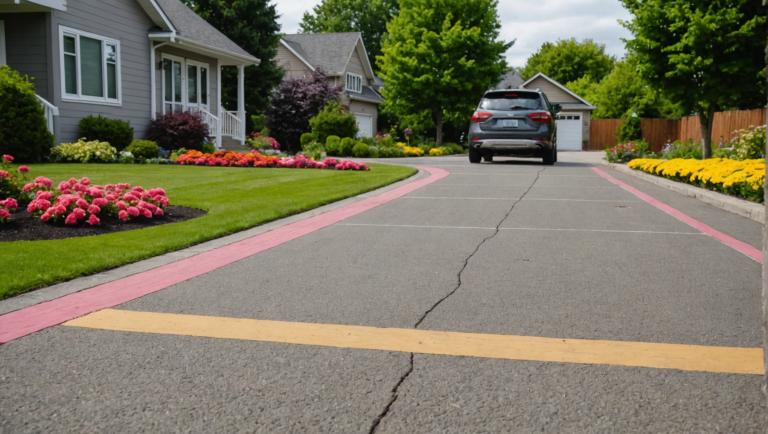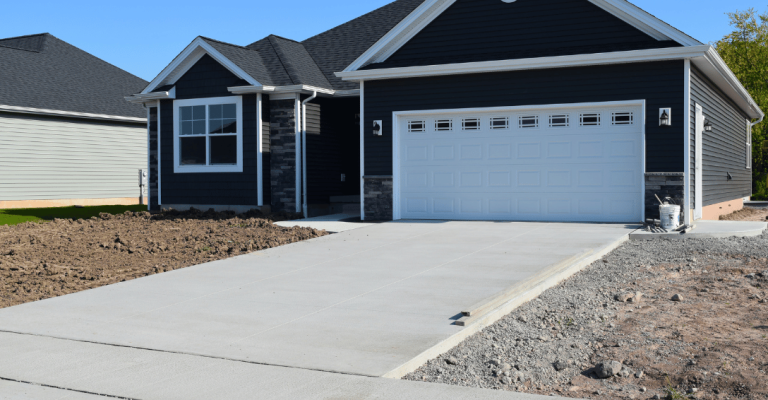Concrete Driveways for Cold Climates Offer Durable and Cost Effective Solutions
As one explores the world of driveway materials suitable for cold climates, the durability and cost-effectiveness of concrete driveways stand out. These driveways, with their ability to withstand harsh weather conditions, freeze-thaw cycles, and deicing salts, offer homeowners a robust solution that demands minimal maintenance. However, is the initial installation cost of a concrete driveway justified in the long run? Could this be the best choice for those residing in cold climate regions, when considering overall durability and cost-efficiency? Let’s evaluate the facts and implications.

Understanding Cold Climate Challenges
To effectively design and maintain a concrete driveway for cold climates, it is essential to first comprehend the unique challenges posed by such climates. These challenges include drastic temperature fluctuations, freeze-thaw cycles, and the impact of deicing salts.
Drastic temperature fluctuations can cause concrete to expand and contract, leading to cracks and degradation over time. These fluctuations are common in cold climates where temperatures can change significantly within a 24-hour period.
Freeze-thaw cycles, where water seeps into the concrete, freezes, expands, and then thaws, can create pressure that leads to cracking and surface scaling. This is particularly damaging to concrete driveways as they are constantly exposed to the elements.
Deicing salts, frequently used in cold climates, can also damage a concrete driveway. These salts can cause surface scaling and subflorescence – a white, powdery substance that forms on the surface of the concrete. Moreover, it can corrode the armature within the concrete, leading to further structural damage.
Why Choose Concrete Driveways?
Despite these challenges, one might wonder why concrete remains a popular material choice for driveways in cold climates? The answer lies in the unique combination of attributes that concrete brings to the table.
First and foremost, concrete has an inherent ability to withstand the freeze-thaw cycles that are common in cold climates. Unlike other materials, concrete does not deteriorate significantly when subjected to repeated freezing and thawing. This resilience makes it a cost-effective solution in the long run.
Additionally, concrete’s thermal mass properties contribute to its popularity. It has the ability to absorb and retain heat, making it less prone to icing during extreme cold conditions. This feature not only facilitates easy maintenance but also promotes safety by reducing the risk of accidents due to icy surfaces.
Lastly, concrete offers an aesthetic advantage. It provides a clean, modern look and can be customized with a variety of finishes, colors, and patterns to complement any architectural style. This versatility makes concrete an appealing choice for homeowners who wish to enhance their property’s curb appeal.
The Durability of Concrete
The durability of concrete is an essential factor to keep in mind when constructing driveways, particularly in cold climates. Two primary aspects to assess are its resistance to weather conditions and cost-effectiveness.
A thorough examination of these aspects will provide an understanding of why concrete is a superior choice for such environments.
Concrete’s Weather Resistance
Remarkably resilient, concrete stands as an ideal choice for cold climates due to its inherent weather resistance and unparalleled durability. This substance’s compositional structure is incredibly dense, which allows it to withstand harsh conditions and the freeze-thaw cycles that are common in colder climates.
Concrete’s inherent resistance to weathering is due to its unique physical and chemical characteristics. The primary physical characteristic that contributes to concrete’s weather resistance is its density. This density makes it highly resistant to erosion and deterioration caused by wind, precipitation, and temperature fluctuations.
Moreover, the chemical composition of concrete includes elements such as calcium, silicon, and aluminum, which interact to form a hydration product that is resistant to dissolution and leaching, thereby increasing the material’s durability.
Additionally, concrete’s thermal mass properties contribute to its weather resistance. Thermal mass refers to a material’s ability to absorb and store heat, then slowly release it. In colder climates, concrete driveways can absorb heat during the day and gradually release it at night, reducing the risk of frost damage.
Cost-Effectiveness of Concrete
In evaluating the cost-effectiveness of concrete, a critical factor to take into account is its exceptional durability, which offers long-term savings by reducing the need for repairs or replacements. Concrete’s inherent strength and longevity make it an ideal material choice for enduring harsh weather conditions prevalent in colder climates. Its resilience, coupled with its low maintenance requirements, can meaningfully decrease overall lifecycle costs, delivering a superior return on investment.
Moreover, the economic advantages of concrete extend beyond its physical properties. The vast availability of the raw materials required for its production contributes to its cost-effectiveness. Concrete’s constituents, primarily limestone, are abundant worldwide, making it an economically prudent choice for large-scale infrastructural projects.
Furthermore, technological advancements in concrete mix design have led to improved performance characteristics, including enhanced durability, resistance to freeze-thaw cycles and reduced permeability. These developments have resulted in substantial cost savings over the long term, increasing concrete’s cost-effectiveness.
Concrete Driveways: A Cost-Effective Solution
Opting for concrete driveways presents a cost-effective solution, offering a blend of durability, low-maintenance, and aesthetic appeal that other options often fail to match. The initial cost of installing a concrete driveway may be higher than other materials such as asphalt or gravel. However, when considering long-term costs, concrete proves to be a wise investment. Its robust characteristics allow it to withstand harsh weather conditions, making it an ideal choice for cold climates.
Hydration, the chemical reaction that causes concrete to harden, continues for years, making the surface increasingly durable over time. This longevity reduces the need for frequent replacements or repairs, saving homeowners considerable amounts of money in the long run.
Moreover, concrete driveways require minimal maintenance. Regular sealing every few years is usually sufficient to protect it from weathering and stains, further reducing its lifetime costs.
Installation Process for Concrete Driveways
The installation process for concrete driveways in cold climates involves two critical stages: ground preparation and the concrete pouring technique.
Ground preparation guarantees a stable and durable base, while the concrete pouring technique determines the longevity and resistance of the driveway to weathering.
Understanding these stages in detail is essential for constructing driveways that withstand cold climate conditions.
Preparing the Ground
Frequently, successful installation of concrete driveways hinges on thorough preparation of the ground, a process that involves several essential steps designed to enhance durability and longevity.
First, excavate the site to the necessary depth, considering factors like the driveway’s planned thickness, base thickness, and frost line depth specific to your climate. This guarantees that the driveway can withstand frost heave, a common problem in cold climates.
The ground should be compacted using a plate compactor to provide a solid base. This step is vital, as lax compaction contributes to potential sinking and cracking.
Following compaction, install a geotextile fabric. This synthetic material aids in stabilizing the ground, preventing soil migration, and enhancing the driveway’s load-bearing capacity.
Next, apply a layer of sub-base material, such as crushed stone or gravel. This serves a dual function: it provides further stability and facilitates drainage, mitigating water-related damage. The sub-base thickness should be adjusted according to the anticipated vehicle load and local weather conditions.
Lastly, make sure the ground is graded properly for effective water runoff. An improper slope can lead to water pooling on the driveway, accelerating deterioration.
Concrete Pouring Technique
After meticulously preparing the ground, the next crucial phase in the installation of a concrete driveway involves the application of a specific concrete pouring technique that guarantees durability and longevity. The process begins with the careful mixing of concrete, ensuring that the ratio of water to cement is optimal for preventing freeze-thaw damage in cold climates. This balance is important as too much water can lead to a weak driveway susceptible to cracking while too little can make the concrete unworkable.
The concrete is then poured into the prepared driveway form. The pouring should be done swiftly to prevent the concrete from setting prematurely. It is essential to minimize the time between mixing and pouring to increase the strength of the finished driveway. Once the concrete is poured, it should be spread evenly across the form using a screed board.
The final step in the pouring process is the curing, a controlled process that allows the concrete to harden while retaining its moisture. This process typically takes about a month, during which the driveway is kept damp to prevent the surface from drying too quickly, which could cause surface cracking. Proper curing ensures an enduring, long-lasting driveway even in the harshest of cold climates.
Maintenance Tips for Concrete Driveways
Proper maintenance of concrete driveways, particularly in cold climates, necessitates a thorough understanding of the unique challenges posed by the harsh weather conditions. Cold environments can lead to freeze-thaw cycles that affect the concrete’s structural integrity, highlighting the need for a specialized maintenance approach.
One essential maintenance tip is applying a high-quality concrete sealer. The sealer acts as a barrier, protecting the driveway from the ingress of moisture, which can freeze and cause cracks. It also safeguards against de-icing salts that can lead to surface scaling. Regular reapplication, typically every two to three years, is recommended for sustained durability.
Another tip is to guarantee the driveway is kept clean and free from standing water. Debris and dirt can trap moisture, increasing the risk of freeze-thaw damage. Regular sweeping and occasional pressure washing can help alleviate this risk.
Lastly, avoid the use of de-icing chemicals during the winter months. These agents can accelerate freeze-thaw cycles, leading to premature concrete deterioration. Instead, use sand for traction or invest in a snowblower or professional snow removal service to keep your driveway clear.
Dealing With Concrete Driveway Damage
Despite the best maintenance efforts, concrete driveways in cold climates may still sustain damage due to the severity of weather conditions, necessitating effective repair strategies.
The low temperatures can cause the water trapped in the concrete’s pores to freeze and expand, leading to cracking and spalling.
Identifying the type of damage is the primary step in dealing with these issues. Cracking, for instance, can be categorized into several types, including shrinkage, heaving, and settlement cracks. Each requires a specific repair methodology to ensure long-term effectiveness.
Shrinkage cracks, for example, require filling with a flexible sealant that can withstand concrete movement, while settlement cracks may necessitate slabjacking to restore levelness.
Additionally, for spalling or surface scaling, it is recommended to remove loose particles and apply a high-quality resurfacer. This process restores the driveway’s appearance and protects it from further damage.
It’s essential to remember that the use of de-icing salts during winter can exacerbate concrete damage. Thus, the selection of ice-melting products should be done thoughtfully and preferably avoid those containing ammonium nitrates and ammonium sulphates.
Case Study: Concrete Vs Asphalt
An in-depth analysis of concrete and asphalt as materials for driveways in cold climates reveals distinctive characteristics and performance attributes essential in determining their suitability. Concrete’s inherent strength and durability make it a robust choice for cold climates. It efficiently handles freeze-thaw cycles and exhibits less susceptibility to frost heave. However, it may require sealing to prevent water penetration and potential damage.
Asphalt, on the other hand, offers excellent flexibility, which can be advantageous in cold climates where ground movement due to freeze-thaw cycles is prevalent. It is also black, promoting snow melt on driveways. The downside is its vulnerability to petroleum spills and its need for more frequent maintenance.
The following table provides a side-by-side comparison of these two materials:
| Concrete | Asphalt | |
|---|---|---|
| Durability | High | Moderate |
| Maintenance | Low | High |
| Cost | High upfront, low long-term | Low upfront, high long-term |
Each material has its pros and cons, and the choice depends on the specific requirements, budget considerations, and personal preferences of the homeowner. This understanding facilitates informed decisions, fostering a sense of belonging within our community of readers.
Making the Switch: Your Next Steps
Having assessed the pros and cons of concrete and asphalt driveways in cold climates, we now shift our focus to the necessary steps involved in making a material switch for your driveway.
The first step, site assessment, is vital. This requires a thorough analysis of your current driveway’s condition and its surrounding terrain.
Next, you’ll need to calculate the cost for removal of the existing material, which will depend on its size, thickness, and complexity.
Once you’ve assessed your budget, you’ll need to choose a contractor. It’s important to select a contractor with experience in cold climates, as they will be familiar with the technical nuances that can guarantee the durability of your concrete driveway.
The next phase involves preparation of the site, which includes removal of the old material, grading, and ensuring proper drainage. Once this is complete, the concrete can be poured and finished.
Lastly, it’s crucial to plan for maintenance. Regular sealing can prolong the life of your concrete driveway, particularly in cold climates.
Frequently Asked Questions
What Are Some Creative Design Options for Concrete Driveways?
Creative design options for concrete driveways include stamped patterns that mimic brick or stone, exposed aggregate for a textured look, colored concrete for unique aesthetics, and incorporating geometric shapes for a modern appeal.
Can Concrete Driveways Be Installed Over Existing Driveways?
Yes, concrete driveways can be installed over existing ones, provided the current structure is sound and stable. This method, known as overlaying, promotes cost-effectiveness, time efficiency, and environmental sustainability by reducing waste generation.
How Long Does It Typically Take to Install a Concrete Driveway?
The installation duration of a concrete driveway depends on various factors, including size and weather conditions. However, typically, the process takes 1-2 days for preparation, 1 day for pouring concrete, and up to 7 days for curing.
What Are the Environmental Impacts of Choosing a Concrete Driveway?
Concrete driveways, while durable and cost-effective, do have environmental impacts. These include high carbon dioxide emissions during production, depletion of natural resources, and potential for water runoff, which can contribute to local flooding and water pollution.
Are There Any Potential Health Risks Associated With Concrete Driveways?
While concrete driveways pose minimal direct health risks, they can contribute to urban heat islands, leading to increased temperatures, which may exacerbate heart and respiratory conditions. Proper maintenance and sealing can mitigate these potential issues.






